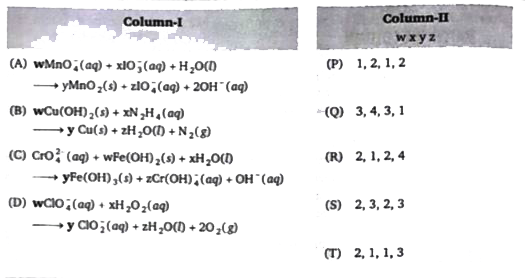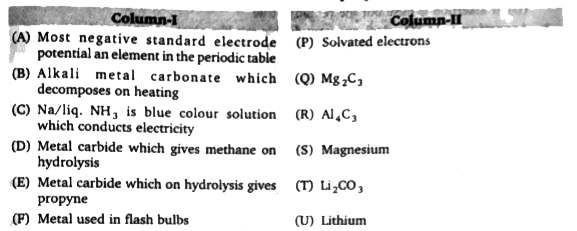Match the enteries of column I with appropriate entries of column II Each entry in column I may have one or more than one correct option from column II .
Column I Column II (A)C1 ,Br, I(p)Ionization enthalpy increases (B)B,C,O (q)Negative elecron gain enthalpy decreases (C)O2−,O−,O−, O(r) Atomic size decreases (D)C1 ,F ,P(s)Belong to the same group
The correct Answer is:A, B, C, D
To match the entries of Column I with the appropriate entries of Column II, we will analyze each entry in Column I and determine which options from Column II are correct based on the properties of the elements involved.
1. Entry A: Cl, Br, I
- These elements belong to Group 17 (halogens).
- Match with (s): "Belong to the same group" is correct because Cl, Br, and I are all halogens.
- Match with (q): "Negative electron gain enthalpy decreases" is also correct. As you move down the group, the ability to gain electrons decreases due to increasing atomic size.
- No match with (p): "Ionization enthalpy increases" is incorrect because ionization enthalpy decreases down the group.
Matches for A: (s), (q)
2. Entry B: B, C, O
- These elements are in the same period (2nd period).
- Match with (r): "Atomic size decreases" is correct because atomic size decreases across a period.
- No match with (s): They do not belong to the same group.
- No match with (p): "Ionization enthalpy increases" is correct, but the statement is about decreasing, so it is incorrect.
- No match with (q): "Negative electron gain enthalpy decreases" is incorrect; electron gain enthalpy actually increases across the period.
Matches for B: (r)
3. Entry C: O^(2-), O^(-), O
- These are isoelectronic species.
- Match with (r): "Atomic size decreases" is correct. The more negative charge an ion has, the larger it is, so O^(2-) is larger than O^(-), which is larger than O.
- No match with (s): They do not belong to the same group.
- No match with (p): "Ionization enthalpy increases" is incorrect; it actually decreases as you go from O to O^(-) to O^(2-).
- Match with (q): "Negative electron gain enthalpy decreases" is correct because the tendency to gain electrons decreases as the negative charge increases.
Matches for C: (r), (q)
4. Entry D: Cl, F, P
- Cl and F are halogens, while P is a non-metal in Group 15.
- Match with (s): "Belong to the same group" is incorrect; Cl and F are in Group 17, but P is in Group 15.
- No match with (r): Atomic size does not follow a consistent trend among these three.
- Match with (q): "Negative electron gain enthalpy decreases" is correct. Cl has a higher electron gain enthalpy than P.
- No match with (p): "Ionization enthalpy increases" is incorrect; Cl has a higher ionization enthalpy than P.
Matches for D: (q)
Final Matches:
- A: (s), (q)
- B: (r)
- C: (r), (q)
- D: (q)
- These elements belong to Group 17 (halogens).
- Match with (s): "Belong to the same group" is correct because Cl, Br, and I are all halogens.
- Match with (q): "Negative electron gain enthalpy decreases" is also correct. As you move down the group, the ability to gain electrons decreases due to increasing atomic size.
- No match with (p): "Ionization enthalpy increases" is incorrect because ionization enthalpy decreases down the group.
- These elements are in the same period (2nd period).
- Match with (r): "Atomic size decreases" is correct because atomic size decreases across a period.
- No match with (s): They do not belong to the same group.
- No match with (p): "Ionization enthalpy increases" is correct, but the statement is about decreasing, so it is incorrect.
- No match with (q): "Negative electron gain enthalpy decreases" is incorrect; electron gain enthalpy actually increases across the period.
- These are isoelectronic species.
- Match with (r): "Atomic size decreases" is correct. The more negative charge an ion has, the larger it is, so O^(2-) is larger than O^(-), which is larger than O.
- No match with (s): They do not belong to the same group.
- No match with (p): "Ionization enthalpy increases" is incorrect; it actually decreases as you go from O to O^(-) to O^(2-).
- Match with (q): "Negative electron gain enthalpy decreases" is correct because the tendency to gain electrons decreases as the negative charge increases.
- Cl and F are halogens, while P is a non-metal in Group 15.
- Match with (s): "Belong to the same group" is incorrect; Cl and F are in Group 17, but P is in Group 15.
- No match with (r): Atomic size does not follow a consistent trend among these three.
- Match with (q): "Negative electron gain enthalpy decreases" is correct. Cl has a higher electron gain enthalpy than P.
- No match with (p): "Ionization enthalpy increases" is incorrect; Cl has a higher ionization enthalpy than P.
- A: (s), (q)
- B: (r)
- C: (r), (q)
- D: (q)
Topper's Solved these Questions
- CLASSIFICATION OF ELEMENTS AND PERIODICITY IN PROPERTIES Book:PRADEEPChapter:CLASSIFICATION OF ELEMENTS AND PERIODICITY IN PROPERTIES Exercise:Competition Focus (Jee Main and Advanced / Medical Entrance ) ( Integer Type Question VI)
Explore 6 Videos
- CLASSIFICATION OF ELEMENTS AND PERIODICITY IN PROPERTIES Book:PRADEEPChapter:CLASSIFICATION OF ELEMENTS AND PERIODICITY IN PROPERTIES Exercise:Competition Focus (Jee Main and Advanced / Medical Entrance ) ( Assertion - Reason Type Question ) (Type I)
Explore 6 Videos
- CLASSIFICATION OF ELEMENTS AND PERIODICITY IN PROPERTIES Book:PRADEEPChapter:CLASSIFICATION OF ELEMENTS AND PERIODICITY IN PROPERTIES Exercise:Competition Focus (Jee Main and Advanced / Medical Entrance ) ( Multiple Choice Question IV ) (Matching Type Question )
Explore 4 Videos
- CHEMICAL BONDING AND MOLECULAR STRUCTUREBook:PRADEEPChapter:CHEMICAL BONDING AND MOLECULAR STRUCTUREExercise:Curiosity Questions
Explore 2 Videos
- ENVIRONMENTAL CHEMISTRYBook:PRADEEPChapter:ENVIRONMENTAL CHEMISTRYExercise:COMPETITION FOCUS (JEE(Main and Advanced)/Medical Entrance (VI.ASSERTION-REASON) Type II
Explore 6 Videos
Similar Questions
Match the enteries of column I with appropriate entries of column II Each entry in column I may have one or more than one correct option from column II .
Column I Column II (A)C1 ,Br, I(p)Ionization enthalpy increases (B)B,C,O (q)Negative elecron gain enthalpy decreases (C)O2−,O−,O−, O(r) Atomic size decreases (D)C1 ,F ,P(s)Belong to the same group
View SolutionEntries of Column-I are to be matched with entries of Coloumn-II. Each entry of Column-I may have the matching with one or more than one entries of Column-II.

View SolutionEntries of Column-I are to be matched with entries of Coloumn-II. Each entry of Column-I may have the matching with one or more than one entries of Column-II.

View SolutionEntries of Column-I are to be matched with entries of Coloumn-II. Each entry of Column-I may have the matching with one or more than one entries of Column-II.

View SolutionEntries of Column-I are to be matched with entrices of Column-II. Each entry of Column-I may have the matching with one or more than entries of Column-II

View SolutionEntries of Column-I are to be matched with entrices of Column-II. Each entry of Column-I may have the matching with one or more than entries of Column-II

View SolutionEntries of Column-I are to be matched with entrices of Column-II. Each entry of Column-I may have the matching with one or more than entries of Column-II

View SolutionEntries of Column-I are to be matched with entrices of Column-II. Each entry of Column-I may have the matching with one or more than entries of Column-II

View SolutionEntries of Column-I are to be matched with entrices of Column-II. Each entry of Column-I may have the matching with one or more than entries of Column-II

View SolutionEntries of Column-I are to be matched with entrices of Column-II. Each entry of Column-I may have the matching with one or more than entries of Column-II

View Solution

